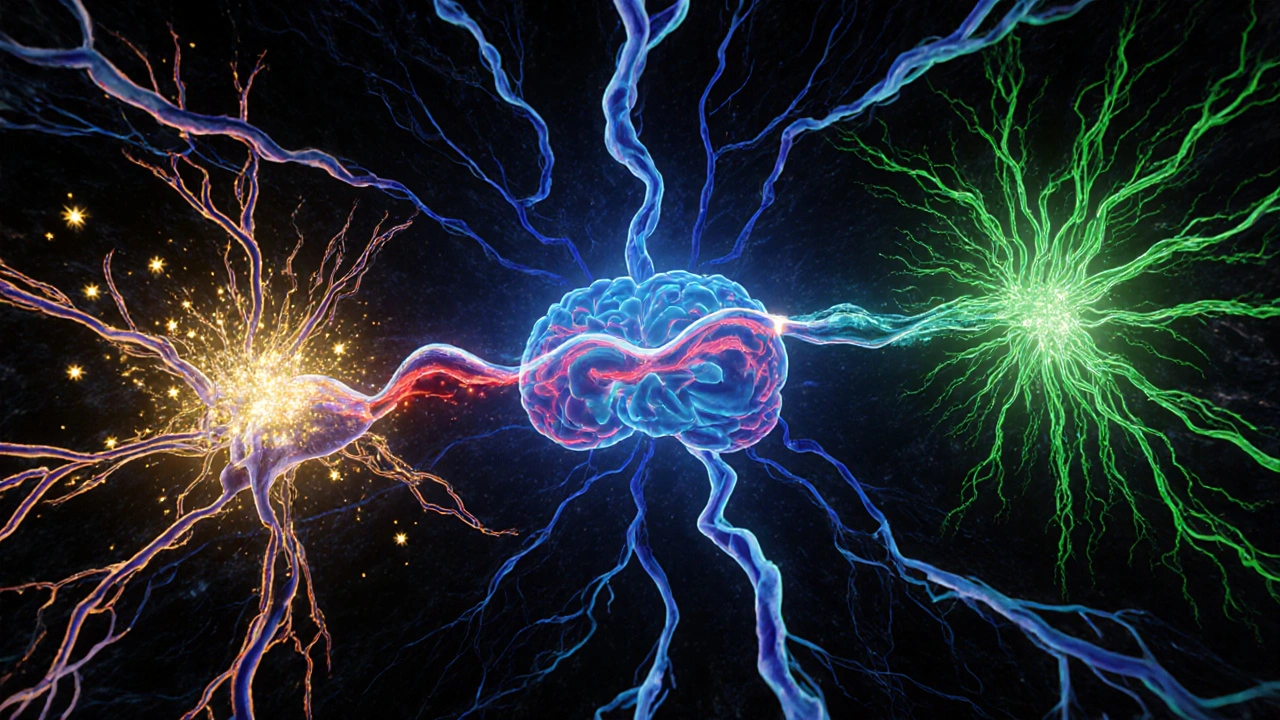Calcitriol and Mood Disorders: How Vitamin D Impacts Depression and Anxiety
 Oct, 24 2025
Oct, 24 2025
Ever wonder why some people feel down when the days get shorter? Or why a simple blood test can sometimes explain persistent anxiety? The answer might lie in a tiny hormone called calcitriol, the active form of vitamin D. Below we’ll unpack what calcitriol does, how it talks to the brain, and what the latest research says about its role in mood disorders like depression and anxiety.
What is calcitriol?
Calcitriol is the hormonally active metabolite of vitamin D, officially known as 1,25-dihydroxyvitamin D3. It is produced in the kidneys from its precursor, 25-hydroxyvitamin D, after the body senses low calcium levels. Once formed, calcitriol binds to vitamin D receptors (VDR) found in almost every cell, from bone to immune cells. Its primary job is to keep calcium and phosphate in balance, ensuring strong bones and proper muscle function. But calcitriol’s reach goes far beyond the skeleton; it also influences immune responses, hormone regulation, and-crucially for our topic-brain chemistry.
Understanding mood disorders
Mood disorders refer to a group of mental health conditions characterized by persistent disturbances in emotional state. The most common forms are depression and anxiety, but the umbrella also includes bipolar disorder, seasonal affective disorder (SAD), and others. While genetics set the stage, lifestyle, stress, and biochemical factors all play starring roles. Neurotransmitters like serotonin, dopamine, and norepinephrine are the usual suspects, but recent studies suggest that vitamin D pathways, especially calcitriol, might be pulling some of the strings.
How calcitriol talks to the brain
Three main pathways connect calcitriol to mood regulation:
- Neurotransmitter synthesis: VDR activation in brain cells boosts the production of serotonin‑producing enzymes, potentially lifting mood.
- Neuroinflammation control: Calcitirol suppresses pro‑inflammatory cytokines (like IL‑6 and TNF‑α) that have been linked to depressive symptoms.
- Neurotrophic support: It up‑regulates brain‑derived neurotrophic factor (BDNF), a protein that helps neurons survive and form connections-key for learning and emotional resilience.
Think of calcitriol as a multitool for the brain: it helps make the chemicals that keep us upbeat, keeps inflammation in check, and supports the health of the neural wiring.

Evidence from clinical research
For a long time, the link between vitamin D and mood was mostly anecdotal. In the past decade, however, a wave of well‑designed studies gave us clearer numbers.
Below is a quick snapshot of the most cited trials:
| Study design | Population | Intervention | Primary mood measure | Result |
|---|---|---|---|---|
| Randomized Controlled Trial (RCT) | 200 adults with mild‑to‑moderate depression | 2,000 IU vitamin D3 daily (average serum rise 12 ng/mL) | Hamilton Depression Rating Scale (HAM‑D) | Mean HAM‑D reduction 4.2 points vs 1.1 in placebo (p<0.01) |
| Observational cohort | 5,000 community members, baseline serum 25‑OH‑D measured | Natural vitamin D status (no supplementation) | PHQ‑9 scores | Each 10 ng/mL increase in 25‑OH‑D associated with 0.7‑point PHQ‑9 drop (95% CI 0.5‑0.9) |
| RCT (calcitriol specific) | 120 patients with treatment‑resistant anxiety | 0.5 µg calcitriol oral weekly | Beck Anxiety Inventory (BAI) | BAI lowered by 6.5 points vs 2.0 in control (p=0.03) |
| Seasonal affective disorder trial | 80 individuals diagnosed with SAD | High‑dose vitamin D3 (5,000 IU) for 8 weeks | Seasonal Pattern Assessment Questionnaire (SPAQ) | Improvement in 68% of participants vs 31% on placebo |
Across these studies, the pattern is clear: higher vitamin D status-often reflected by higher calcitriol activity-correlates with measurable reductions in depressive and anxious symptoms. However, not every trial shows a dramatic effect; study design, baseline deficiency levels, and dosage matter a lot.
Practical implications: Should you boost calcitriol?
If you’re wrestling with low mood, a sensible first step is to check your vitamin D levels. Most labs report 25‑hydroxyvitamin D (25‑OH‑D). If you’re below 20 ng/mL, you’re considered deficient, and supplementation is likely to raise calcitriol production.
Here’s a simple roadmap:
- Get tested: A blood test for 25‑OH‑D costs around $30‑$50 and can be done through most primary‑care clinics.
- Start with vitamin D3: For most adults, 1,000-2,000 IU daily is safe and effective. People with severe deficiency may need 5,000 IU daily for a few weeks, under doctor supervision.
- Consider calcitriol only when needed: Direct calcitriol prescriptions are rare and usually reserved for patients with kidney disease or malabsorption who can’t convert vitamin D efficiently.
- Track mood changes: Use a validated tool like PHQ‑9 (for depression) or GAD‑7 (for anxiety) every 2‑4 weeks to see if symptoms improve.
- Pair with lifestyle fixes: Sun exposure, regular exercise, and a balanced diet (rich in omega‑3s and magnesium) amplify the benefits.
Remember, vitamin D is not a cure‑all. It works best as part of a broader mental‑health plan that includes therapy, sleep hygiene, and, when appropriate, medication.
Potential risks and cautions
Too much calcitriol can lead to hypercalcemia-high calcium in the blood-which may cause nausea, kidney stones, or heart rhythm issues. This risk is low with normal vitamin D3 doses but rises if you combine high‑dose supplements with calcium‑rich diets or certain medications (like thiazide diuretics).
People with sarcoidosis, granulomatous diseases, or chronic kidney disease should avoid self‑prescribing calcitriol without medical guidance, as their bodies may already over‑produce the hormone.
Key takeaways
- Calcitriol is the active form of vitamin D that influences calcium balance and brain chemistry.
- It supports serotonin synthesis, reduces neuroinflammation, and boosts BDNF-processes linked to better mood.
- Clinical trials consistently show that raising vitamin D status improves depressive and anxious scores, especially in people who start out deficient.
- Testing 25‑OH‑D, supplementing responsibly, and monitoring symptoms are practical steps for anyone interested in the vitamin D‑mood connection.
- Excessive dosing can cause hypercalcemia; always consult a healthcare professional before high‑dose regimens.
Can vitamin D deficiency cause depression?
Evidence suggests that low 25‑OH‑D levels are associated with higher rates of depressive symptoms. While deficiency alone rarely triggers full‑blown clinical depression, correcting it can lower symptom severity in many patients.
Is calcitriol the same as vitamin D3?
No. Vitamin D3 (cholecalciferol) is the inert precursor you get from sunlight or supplements. Calcitriol is the hormonally active form produced in the kidneys after conversion.
How much vitamin D should I take to improve mood?
Most guidelines recommend 1,000-2,000 IU daily for adults. Those with severe deficiency may need higher doses (up to 5,000 IU) for a short period, but this should be supervised by a clinician.
Can I get enough calcitriol from sunlight alone?
Sun exposure helps the skin produce vitamin D3, which the body then converts to calcitriol. However, factors like latitude, skin pigmentation, sunscreen use, and indoor lifestyles often limit production, so supplements are a reliable fallback.
Are there any side effects of taking calcitriol directly?
Direct calcitriol therapy can cause hypercalcemia, especially when taken in high doses or combined with calcium‑rich diets. It’s typically reserved for patients with specific kidney or absorption issues and must be monitored by a doctor.


Shirley Slaughter
October 24, 2025 AT 12:30Wow, the way calcitriol weaves into our brain chemistry is practically a masterpiece of nature. First, think about serotonin – the happy chemical – and how vitamin D receptors actually boost the enzymes that make it. Then there’s the inflammation side, where calcitriol tells those nasty cytokines to back off, which is a huge deal for mood stability. Add to that the BDNF factor, the brain’s own growth hormone, and you have a multitool that keeps neurons happy and connected. Research over the past decade finally started to back up what the folklore has whispered for ages: low vitamin D levels correlate with higher depression scores. In randomized trials, participants who got a modest dose of vitamin D showed a measurable drop in HAM‑D scores compared to placebo. Even in anxiety‑heavy cohorts, supplementing helped lower GAD‑7 results, suggesting a calming effect. The hormone also seems to regulate calcium in the brain, which influences neurotransmitter release. There’s even emerging data on seasonal affective disorder, where winter darkness slashes our endogenous vitamin D and mood takes a nosedive. If you’re feeling the winter blues, a simple blood test for 25‑hydroxyvitamin D could be the first step. Supplementation isn’t a miracle cure, but it’s like adding a supportive friend to the treatment plan. And because calcitriol is active, it can cross the blood‑brain barrier efficiently. In short, think of calcitriol as a backstage crew member keeping the spotlight on your mental health. So next time you’re stuck in a slump, check your vitamin D levels – your brain might thank you.
Remember, always talk to a healthcare professional before starting any supplement regimen.
Sean Thomas
October 28, 2025 AT 09:30Listen, the whole vitamin‑D‑mood thing is just a smokescreen for the global pharma agenda. They push these “studies” to get us buying endless supplements while the real culprits are the chemicals they’re spraying in the sky. You can’t trust any of this, wake up!
Aimee White
November 1, 2025 AT 07:30Honestly, the idea that a tiny hormone can control our emotions is straight out of a sci‑fi conspiracy. The elites want us dependent on their fortified drinks and pills so they can monitor our brain activity. The truth is hidden, the power of calcitriol is being weaponized.
Javier Muniz
November 5, 2025 AT 05:30Hey folks, let’s keep it grounded. While supplements can help when you’re deficient, they’re not a cure‑all. Mental health is complex – therapy, lifestyle, and sometimes meds are all part of the puzzle. Vitamin D is just one piece.
Theo Asase
November 9, 2025 AT 03:30What a load of pop‑science drivel! They parade around a few lab results and claim calcitriol is the silver bullet for depression. Wake up, sheeple! The real fix is strengthening our nation's borders and staying true to our roots.
Nelson De Pena
November 13, 2025 AT 01:30Let’s keep the conversation constructive. The data does show modest benefits for people with low baseline levels. It’s not a miracle, but for those who are deficient, adding vitamin D can be a valuable adjunct to standard care.
Wilson Roberto
November 16, 2025 AT 23:30From a philosophical standpoint, the interplay between biology and experience underscores how intertwined our physical and mental realms are. Supplements like calcitriol may serve as catalysts, but the meaning we derive from life remains a personal narrative.
Samantha Vondrum
November 20, 2025 AT 21:30Esteemed colleagues, the comprehensive review of calcitriol's mechanistic pathways underscores its potential utility as an adjunctive therapy in affective disorders. Nonetheless, rigorous longitudinal trials remain imperative to substantiate causality.
Ed Mahoney
November 24, 2025 AT 19:30Oh sure, because a pill is going to solve the existential dread that comes from watching the news. Great, now we can blame our anxiety on a vitamin level instead of the fact that the world is a mess.
Selina M
November 28, 2025 AT 17:30Great info, thanks!
tatiana anadrade paguay
December 2, 2025 AT 15:30Glad you found it helpful! If you’re curious about checking your vitamin D levels, a quick blood test can give you a clear picture and guide any next steps.
Nicholai Battistino
December 6, 2025 AT 13:30Vitamin D isn’t a magic bullet, but low levels can exacerbate mood problems.
Suraj 1120
December 10, 2025 AT 11:30Exactly, the whole system is rigged. The labs hide the real data while they push supplements as a distraction. It’s all part of the control matrix.